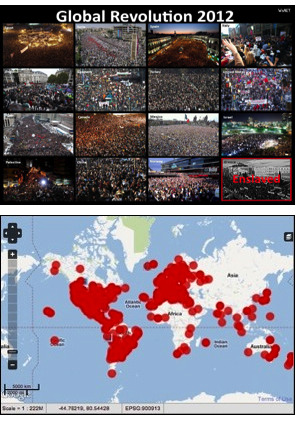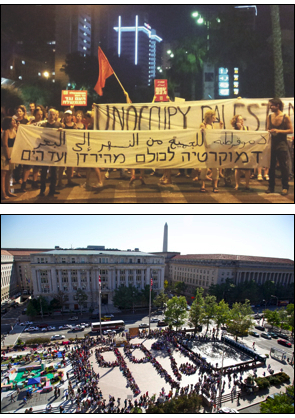Revolution : Ariella Azoulay
|
The Imperial Legacy The concrete formations of oppression and enslavement created by revolutions have not escaped the eyes of citizens and researchers. Still, time and again when all had been said and done and other forms of protest did not seem sufficient in the face of the ruling power’s ability to oppress, revolution continued to appear promising. It was a framework for imagining a different present, a framework by which the power of the many—emerging in space and refusing to be controlled in this way—would be renewed. The permanent distance between ongoing/never ending oppression and the dream of other possibilities, is always given the same dialectic explanation, thus preserving the concept of revolution as an ideic-concept. Some will say revolution must necessarily end in ruling power, this is its destiny; others will say ruling power is revolution’s inevitable price. This explanation did not enable one to see that the ruling power is not what comes after, but rather one force among the various revolutionary forces struggling against the civil power of the many and threatening from the start to prevent its constructing alternative formations of congregation, partnership, and sharing. The actual protest’s global context enhances the ruling power’s threat to civil revolution along two timelines: historic and synchronic. Imperialism has not died but rather morphed and spread worldwide. Through an alliance of nation-states—193 are now registered in the United Nations Organization—it defeats civil existence a priori. Each of these states enjoys the power and authority to produce entire populations as “inadequate” and “temporary,” and expel them from their midst, suffocate and exploit individuals as a labor force, and control borders through which the world economy flows. We live in the shadow of revolutionary violence that constituted such regimes. Common to them is the fact that they were constituted without the agreement of all their governed; regimes split the governed into differential populations, who separately lost their power to demand a constant re-allocation of resources and capital that would enable fair and decent existence for all. The link between the eighteenth-century revolutions and the regime prototype that has spread throughout the world ever since could not be seen when the various revolutions were studied as events demarcated by national sovereignty in space and time. Instead of studying the common civil formation of what took place in the late 1700s in the Atlantic world—the United States, France and Saint Domingue—a formation that ‘made its living’ from the slave trade, researchers examined the results of this formation in the distinct sovereign territories set by regimes constituted at the end of the revolutions, whose rulers aspired to bury the civil within the revolution, the civil revolution. Civil formations of uprising and protest have never died down. When they are learned as a part of one civil language, they cease to appear as limited, failed efforts and emerge Splitting the Concept: Globalization of the civil protest movement began over a decade ago. With the Arab spring continuing to spread across the globe, the differences preserved as incontestable in the West since the eighteenth century between enlightened regimes—liberal-democratic—and dark ones—began to appear as the fruit of ideological violence.14 After over two centuries of regime-made disasters produced by western democracies who cruelly manage the inner and outer relations of the body politic which they rule, civil language burst forth like Esperanto. In different places across the world, crowds speaking it with apparent fluency simply refuse to be dispersed. Whenever it seems they are successfully removed from some city through liberal-democratic temptations, they sprout in another, sometimes in the same state, at times in another, tying threads with other crowds, above and behind the heads of state and tycoons. Simple slogans such as “the state of all its citizens,” “Democracy To All Between The Sea And The River,” “social justice for all” or “we’re the 99%”—when heard simultaneously from different groups in different compounds who, under the existing regimes, had been accustomed to consider one another mutual enemies—sound like the rustle of a civil mass that refuses any ending that is not a re-creation of the body politic of all governed.
In view of the concept’s defects, one is greatly tempted to create a rift in its history and to declare the ideic-concept of revolution as an old, outdated one and formulate a new concept that would account for the events taking place in the recent decade. This, however, would be a limited and problematic move that would have to overlook two contradictions: first—the common concept is still in use at present, and its burial, therefore, would resemble wishful thinking rather than a serious account of the concept of revolution and its linkage to the phenomenal world to which it refers; second—many of the events that possibly seem new, or justifying a new concept, have taken place in the past as well, but were not conceptualized as part of the revolution. A break in the history of the concept would merely perpetuate the idea of revolution as a great and unique event that generates a new beginning and would continue to overlook other civil forms. A commonplace idea is not removable without burying with it the possibility of reconstructing the past potential that never took a distinct shape but was part of the phenomenological world, and without setting aside the role of the concept—in this case the ideic-concept—in shaping that world. Instead of creating a rift in the timeline, then, between the ideic-concept as old and a new concept, I propose to create a rift in the concept itself, breaking it in half. On the one hand, a ruling concept of revolution—aiming to abolish the revolution as a civil happening and replace it with a stable rule that does not express the revolutionary forces that claim their due in the world they share with others, and on the other hand—a civil concept of revolution, that would express the entire governed population and its civil aspirations which time and again are forced to retreat from a rule whose business is ruling rather than the ruled. Through the two parts of the concept, revolution appears again as a possibility. Not a ruling revolution that terminates civil life, but revolution as a civil language that requires many in order to be spoken, and to be renewed everywhere all the time—a civil language that puts an end to sovereign rule and presences a non-differential body of citizens that writes itself anew, in civil language. Sovereign rule as it has been shaped since the eighteenth century, whose object is a differential body of the governed, necessarily clashes with the civil nature of existence and threatens it. Under conditions of differential regimes, any civil activity that aims to imagine citizens as both its point of departure and its objective has a necessarily revolutionary character that should be suppressed. A civil conceptualization of revolution must account for forms and ways of citizens’ congregating with others who they do not necessarily know, to imagine their partnership possible. The patterns of their spreading and taking hold in space need not be tested through single, dramatic, historic events, but rather as discursive goings-on, a part of civil language that under the existing regimes seeks zones in which it can be revived, developed, and spread through the entire body politic by means of all those who constitute it, who—upon using it—would erase all differences built in the body politic and re-imagine it. A civil concept of revolution must be flexible enough to account for that which takes place outside the sphere of rule, a space that is made possible when rule is suspended, a space where individuals congregate and make manifest their aspirations, desires, thoughts, musings, deeds, partnerships, horizons, and insights about shared existence. When the protests, uprisings, rebellions, and civil congregations that have taken place since the eighteenth century are connected, one can suddenly distinguish a whole civil language known to far too many to just remove it from the stage and replace it with another ruling power. It is a language that refuses to retreat for the sake of the ruling power’s order. It is a language whose civil-ness derives not from the civil status of those who are allowed to speak it by the ruling power, but rather from the motley crowd of its speakers, among them those who have never been regarded as legitimate revolutionary subjects because they are non-citizens, refugees, infiltrators, or illegal aliens. When they dared express their claims in public they were regarded as a disturbance to the peace—a nuisance, riot, or insolence that must be squelched at once. These civil happenings that were held at bay as “not revolution” in the past because they did not aspire to grab power, were indeed defeated by the ruling power. Still they created a rich language that now emerges in its myriad layers and in the force with which it has burst into public space, resonating as a comprehensive civil struggle that will not die down until the differential principles of existing regimes in the form of capital and nation, race or gender, are taken apart. 14. Domenico Losurdo, Liberalism – A Counter-History; and Mark Mazower, No Enchanted Palace: The End of Empire and the Ideological Origins of the United Nations (Princeton: Princeton University Press, 2009).↩ |

 instead as an expression of common interest in reviving civil space. Today the passion for civil space bursts forth powerfully wherever colonialism has tread, and threatens to crack the nation-state model that enabled the political, military, and economic elite in each of the nation-states to link itself to a similar elite in other states and thus rule the citizens of the world as their subjects.
instead as an expression of common interest in reviving civil space. Today the passion for civil space bursts forth powerfully wherever colonialism has tread, and threatens to crack the nation-state model that enabled the political, military, and economic elite in each of the nation-states to link itself to a similar elite in other states and thus rule the citizens of the world as their subjects. In the imagined body politic there is no more room for an exceptional population, neither in the form of the privileged who account for hardly one percent, nor as non-citizens who account for a substantial part of the world’s governed population. If the global protest movements engender hope, it is that of the civil revolution, the revolution as a language that should be spoken more and more. No more folds would then be left in the language to contain traces of the possibility that the state would be more than simply the formation of protecting shared life of all the governed, not a means to disintegrate it.
In the imagined body politic there is no more room for an exceptional population, neither in the form of the privileged who account for hardly one percent, nor as non-citizens who account for a substantial part of the world’s governed population. If the global protest movements engender hope, it is that of the civil revolution, the revolution as a language that should be spoken more and more. No more folds would then be left in the language to contain traces of the possibility that the state would be more than simply the formation of protecting shared life of all the governed, not a means to disintegrate it.